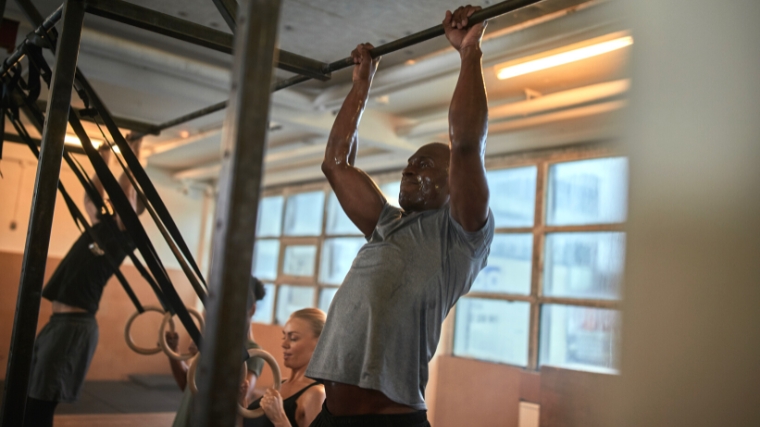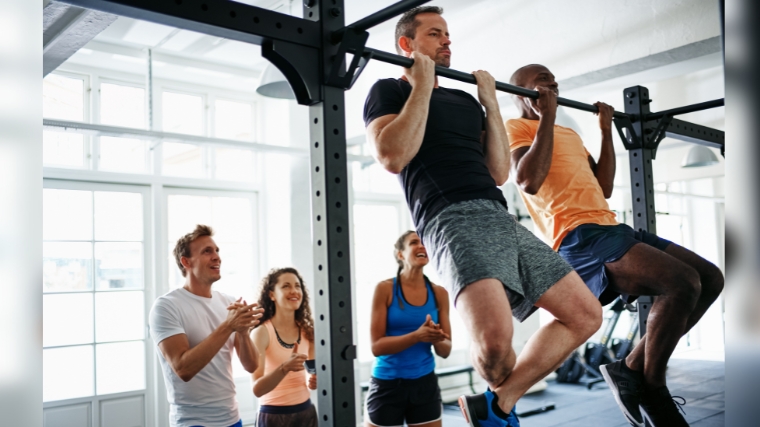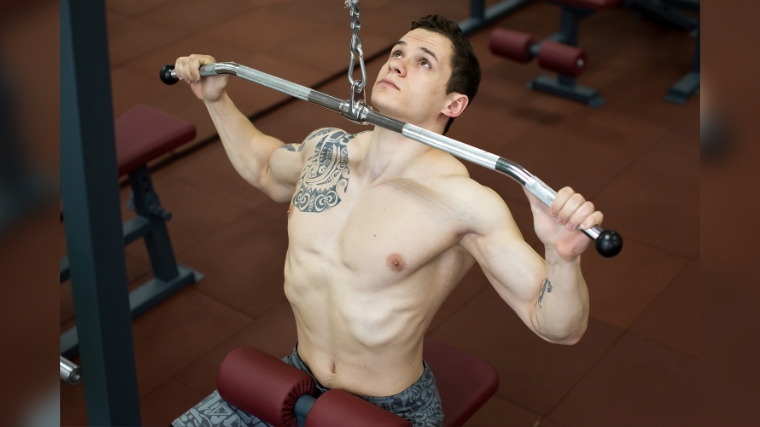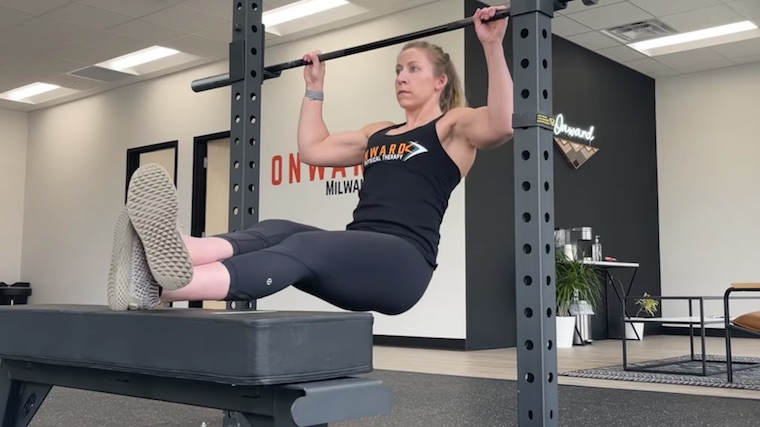Originally Posted At: https://breakingmuscle.com/feed/rss
The pull-up is what many experienced trainers refer to as the “king of upper body exercises.” Although the common gym narrative is to test your worth by finding out how much you bench press, there’s so much more athleticism, utility, and overall transfer from testing your pull-up ability.
It’s a movement that can truly separate the beginners from intermediate and advanced lifters based upon competency. But even for experienced lifters, pull-ups can be challenging. And they can be tough to learn, also.

Aside from basic muscular weakness, there may be a laundry list of reasons why you can’t do bodyweight pull-ups. The smallest old injury, mobility restriction, or joint issue could frustrate your ability to take advantage of this lift. And that’s when it’s handy to have equally effective options to this classic exercise.
Best Pull-Up Alternatives
Flexed Arm Hang
This isometric exercise is a prime alternative to pull-ups for a couple of reasons. First, the amount of time spent under tension in a full lat contraction is unmatched when compared to traditionally performed reps. Normal pull-ups only see this peak contraction for an instant. This variation also reduces the possibility of the biceps entering the picture, making it a more efficient back exercise.

It also allows a lifter to address a common sticking point. Many lifters are weaker in the top position than in other portions of the lift. Many lifters can get halfway up, but start to fade as their chin approaches the bar. Spending a period of time set in that position can remedy the problem, train the upper back muscles, and translate to better pull-up performance.
When to Do It
The flexed arm hang can improve muscular endurance and “closing” strength in the peak contraction of classic pull-ups. In addition to training all the target muscles of the pull-up — the lats, upper back, and biceps — your core works hard to maintain a steady lower body. Since the movement is isometric in nature, there is relatively less potential for injury or risk, since the skeleton is hardly changing position while under tension and your joints can remain stable. It’s a fantastic option for building pull-up strength.
How to Do It
To perform a flexed arm hang, position yourself under a bar, with your in closer-than-normal proximity to the bar itself. This is typically accomplished by standing on a step or box, or jumping into position and locking your body into position. Hold the fully contracted state for the desired amount of time. 15 to 30-second holds is a good place to start.
In this position, it’s easy to allow the shoulders to creep out of position (elevated and with protracted scapulae), so the emphasis must be on maintaining a “proud chest” and a “long neck”.
Once fatigue sets in, it’s common for a lifter to simply let go and forfeit all tension. Instead, allow your body to slowly lower toward a full hang. This will reap the benefits of a heavy eccentric (lowering) rep, which is a great technique for strength gains in and of itself.
Eccentric Pull-Up
Adding time to an eccentric (lowering or stretching) portion of any exercise can strengthen a lifter’s ability on both halves of a lift — the concentric (lifting), as well as the eccentric. (1) Exhausting muscle fibers in the concentric portion of an exercise still leaves a large amount of a lifter’s capacity untapped.

Everyone possesses more eccentric strength (strength on the lowering phase of a movement) than they do concentric strength. Because of this strength bias, working hard to exhaust and “train” that portion of a given lift can improve a lifter’s total strength in that movement while also exposing the lifter to plenty of muscle-building time under tension. (2)
To illustrate: If a lifter’s one-rep max effort bench press was 315 pounds, you would naturally conclude that loading 320 or 325 pounds on the bar would leave them unable to press the weight from their chest. However, if that same lifter was asked to only lower a 325-pound barbell to their chest without pressing it up afterward, their possibility of success would be very high.
When to Do It
Focusing on the lowering phase of the exercise places much more emphasis on time under tension, which is ideal for strengthening muscles and stimulating growth. The eccentric pull-up, in particular, is also great for building grip strength. When a lifter has a bigger frame, their issue might not be a technical element of the lift, it could be the frustration of their overall size making it difficult to possess the strength to complete reps.
For big, heavy lifters, their relative strength will be exploited with this exercise. Even if they perform well in movements like the squat and deadlift, they’re chin-up or pull-up performance often suffers. There’s no other major explanation to be made, other than the sad truth that those are sometimes the breaks when you carry a whole lot of mass.
As a back-dominant exercise, the basic pull-up should generally be a movement that a lifter can perform for reps to tap into the muscular endurance of his postural muscles. It’s up to the lifter to choose the right exercise choices to make that possible, and the eccentric pull-up can be a key player in getting there.
How to Do It
Set up a box or step under the pull-up bar, slightly behind, to the side of, or in front of your body. Stand on top of the box with your head fairly close to the bar. Grab the bar with an overhand grip, outside of shoulder-width and “jump” yourself into the top position of a pull-up — with your elbows near your ribs and your chest close to the bar. Set your shoulders down and back.
Lower yourself slowly with control, while attempting to “brake” your free descent, until the arms are fully extended and you’re in a true dead hang. When you’ve reached the bottom position, step back onto the box and repeat from the top. Focus on sets of three to six reps, with each rep taking five to 10 second for a full descent. Never sacrifice full range of motion, and be sure to do zero work on the concentric phase of the movement — only jump into the top position, don’t try to pull yourself up.
To make this more challenging, add “eccentric isometrics” by pausing for three to five seconds at various segments throughout the descent — at the one-quarter point, the halfway point, and the three-quarters point.
Lat Pulldown
The lat pulldown might be considered more of an “assistance” exercise than a true “alternative,” but it can be highly effective when pull-ups aren’t an option. The movement is somewhat more isolated in nature, as its seated starting position eliminates many core muscles normally involved in a pull-up.

Moreover, the weight being lifted can be adjusted from as low as the weight stack offers (typically 10 or 20 pounds) to the full stack itself, potentially more than the lifter can manage with good form. The makes the muscular demands on the body potentially too low or excessive. But when used properly, with appropriate loading and programming, the lat pulldown can help to target the back, shoulders, and arms in a vertical pulling movement comparable to a full pull-up.
When to Do It
One mistake many people believe about “back exercises” is that that any movement is a good one when it comes to muscular development, shoulder health, and postural correction. With good intentions, some people double-up on their pulling movements, which can include pull-ups, thinking that they are premier strengthening exercises that deliver a positive impact on posture and shoulder health.
However, kyphosis is a significant condition affecting the thoracic spine (upper and middle back) which causes a rounded, “humpback” posture. Most people think that it only affects the spine, but this change in spinal shape has an impact on the rest of the back and ribcage, also. Kyphosis also affects the shoulder blades, pushing them higher and outward into a dysfunctional “winged” position.
This can contribute to shoulder pain, and more importantly, it can mean pull-ups cause your joints more harm than good. Many lifters don’t have great shoulder mobility, and this can be very valuable information to learn before doing pull-ups. It’s a key reason why pulldowns may prove to be a safer, more effective alternative for those with shoulder or upper back issues.
The lat pulldown can allow your torso to lean at a more comfortable angle for the overhead pull, with less shoulder flexion than hanging your full body weight from a pull-up bar, can be a saving grace to shoulder health for those to whom these contraindications apply.
How to Do It
It’s essential that you take the time to position yourself on the seat at the appropriate height. Most lat pulldown setups allow you to adjust to the height of the seat, so you should be sitting far enough that you can just barely reach the bar.
Set your hands in an overhand pull-up grip (around shoulder-width apart should be fine for most lifters), secure your legs under the leg pads, and lean your torso back very slightly.
The starting position should be one where the weight is lifted off the plate-loaded stack when the bar is in your hands and your arms are stretched overhead. In other words, at the top of each rep, the plates shouldn’t crash on top of one another, which would indicate insufficient range of motion.
Set your shoulders by lowering them toward the ground and make your neck long. Focus on driving your elbows down to move the bar toward the torso. Pull with your elbows as far as you can, to feel a deep contraction in your upper and mid-back. Done properly, the bar should stop on or near your upper chest or collarbone area. Pause very briefly before returning to the stretched position.
Rack Pull-Ups
When someone isn’t too great at pull-ups, they can end up doing “whatever it takes” to get up to the bar. As a result, some unwanted and potentially dangerous swinging of their entire body can become an issue.
For that reason, gently resting your feet on an object like a box or bench can be a game-changer to establish muscular control without overwhelming the lift with “too much” assistance.

The idea with the rack pull-up, sometimes called a rack chin, is that your legs to take some of the loading off the body, which can result in a stricter pull-up with more focus on your upper and mid-back. This can be a great option for any lifter concerned with adding size whether or not they’re not great at standard bodyweight pull-ups.
When to Do It
Rack pull-ups create a modification from the full pull-up since some of your body weight is removed from the picture. However, the exercise also allows you to focus more on muscular contraction than core stability through each rep. Add that to the probable reality of being able to crank out more reps per set due to the improved leverage and decreased loading, and you have a wicked tool for hypertrophy.
How to Do It
Set up a flat bench or step near a Smith machine or power rack, with the bar set high enough to allow your body to create a 90-degree angle when your arms are fully extended and your feet are on top of the bench. Grab the bar with an overhand grip beyond shoulder-width. Keep your upper body mostly vertical and your lower body mostly horizontal or angled throughout each repetition. Don’t allow yourself to lean back excessively, turning the exercise into a horizontal row.
You can press gently into the bench with your legs as you pull toward the top position. This adjusts the amount of assistance and control necessary to complete the lift with maximum focus.
Benefits of Pull-Up Alternatives
Choosing an exercise comparable to pull-ups may be necessary for a number of reasons, and each alternative can provide a variety of benefits that can either work around resstrictions or help work toward a full pull-up.
Decreased Strength Requirement
Performing a bodyweight pull-up can be an incredible challenge for many lifters, whether it’s due to a significant body weight, a lack of upper body strength, or a combination of the two. The most effective pull-up alternatives can provide a significant training stimulus regardless of the lifter’s current strength level or overall conditioning.
Adjustable Range of Motion
If shoulder or upper back mobility restrictions prevent full overhead extension, you won’t be able to safely or efficiently display enough force through a full range of motion to benefit from pull-ups. By accommodating an adjusted range of motion, some exercise variations allow you to build strength and muscle size without putting your back and shoulders into a compromised position.
No Pull-Ups, No Problem
Pull-ups are an amazingly useful and productive exercise, but they’re not for everyone. If you can’t yet manage a pull-up, or if you have mobility issues that prevent you from working through a pain-free range of motion, you’re now loaded with plenty of equally effective choices to build your back, shoulders, and arms while addressing the full pull-up in your own time.
References
- Walker, S., Blazevich, A. J., Haff, G. G., Tufano, J. J., Newton, R. U., & Häkkinen, K. (2016). Greater Strength Gains after Training with Accentuated Eccentric than Traditional Isoinertial Loads in Already Strength-Trained Men. Frontiers in physiology, 7, 149. https://doi.org/10.3389/fphys.2016.00149
- Burd, N. A., Andrews, R. J., West, D. W., Little, J. P., Cochran, A. J., Hector, A. J., Cashaback, J. G., Gibala, M. J., Potvin, J. R., Baker, S. K., & Phillips, S. M. (2012). Muscle time under tension during resistance exercise stimulates differential muscle protein sub-fractional synthetic responses in men. The Journal of physiology, 590(2), 351–362. https://doi.org/10.1113/jphysiol.2011.221200
Featured Image: Onward Milwaukee / YouTube
The post The 4 Best Pull-Up Alternatives for Back Strength and Muscle appeared first on Breaking Muscle.
Filed under: Fitness

 For now classes are 6pm and 640pm at 2840 Wildwood st in the Boise Cloggers studio.
Book your class NOW!
click this ==>
For now classes are 6pm and 640pm at 2840 Wildwood st in the Boise Cloggers studio.
Book your class NOW!
click this ==>








